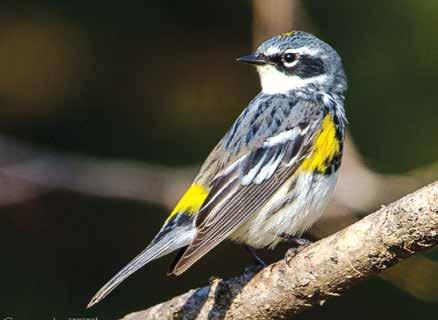
3 minute read
Christmas in the Springtime
My friend Sherry declares, “Spring migration season is Christmas time for birders.” Like the traditional holiday, it’s greatly anticipated and magical, a feast for your eyes and ears, but all too brief—so enjoy it fully! Songbird migration in Kansas City lasts from mid-April to late May, peaking from April 23 to May 15.
First come Ruby-throated Hummingbirds, feeding at bluebells and other early flowers. Baltimore Orioles eat jelly and fruit and scour budding trees for insects. Begin offering nectar around Tax Day. Rose-breasted Grosbeaks flock to feeders and devour your sunflower seeds! Some remain to breed; others travel on to previous nesting territories.
Wood warblers are our “spring superstars”: tiny, colorful birds that pause briefly to refuel en route to northern boreal forests. Approximately 25 of the 43 eastern U.S. species are routinely recorded here. Water sources, mature trees, and sheltering shrubs in your garden increase your chances of savoring these beauties. Remember, “birds can land anywhere during migration!” One memorable May morning, I discovered a flock of golden Yellow Warblers and olive-drab Warbling Vireos—singing exuberantly from a maple tree between two busy urban parking lots.

All long-distance migrants deserve admiration, not only for their beauty but for their amazing strength and resilience. Hummingbirds and grosbeaks may migrate nonstop across the Gulf of Mexico, a single flight of 600 miles. Warblers fledged during a Canadian summer must migrate thousands of miles to Central or South America, survive the winter, then return the following spring. They endure two hazardous journeys before they even have the chance to breed and perpetuate their species! Sadly, mortality is high for migrants—as much as 50%. Adverse weather, predators, collisions with win- dows and towers, and insufficient food and shelter all take a toll. To learn more, consult these excellent books:
• Songbird Journeys: Four Seasons in the Lives of Migratory Birds (Miyoko Chu)
• A Season on the Wind: Inside the World of Spring Migration (Kenn Kaufman)
• Living on the Wind: Across the Hemisphere with Migratory Birds (Scott Weidensaul).
Most songbirds migrate at night, preserving daylight hours for rest and foraging. They navigate using the positions of the stars and moon, and cues from the earth’s magnetic field. Birds take off shortly after sunset and often fly all night in favorable weather conditions. Northerly winds and precipitation may “ground” birds temporarily; southerly winds may allow birds to bypass our area. Sometimes “bad” weather days are the best for seeing birds! Go outdoors on spring nights and listen for the vocalizations of passing flocks overhead. How do we know which species are aloft, and which nights will experience the greatest bird movement? There’s a website for that! BirdCast (https://birdcast.info) provides interactive migration maps, bird counts and more.
Bird songs and calls are a highlight of spring. May and June are the most “talkative” months for local birds. Males sing to defend territories and attract mates. (A few females, such as Northern Cardinals, sing too!) Breeding pairs bond and communicate with quieter “chip notes.” Juveniles vocalize raucously to be fed. The first bird to spot a predator emits “distress calls” to warn others. Birds possess a unique two-part vocal organ, the syrinx, that produces their amazing range of sounds. Each side of the syrinx is independently controlled—so some
ELIZABETH STOAKES Birding Enthusiast
birds, like Wood Thrushes, sing both rising and falling notes simultaneously, or notes on two different pitches. They can even switch from using one side of the syrinx to the other, so that they can sing for prolonged periods without stopping for breath!
To experience a glorious symphony, don’t miss the “dawn chorus.” Early risers such as American Robins begin to sing in darkness; the volume swells as the sun rises and other species join in. A brief sample recording from a Virginia forest, featuring Eastern Phoebes, Carolina Wrens, and Yellowthroated Vireos among the performers, can be found in the Wikipedia article “Dawn Chorus.” According to ornithologists, species that roost highest in the trees, and birds with the largest eyes, detect daylight first, and sing the earliest. The free Merlin birding app can help you to identify different species in the mix. The concert trails off by full daylight, as birds turn to foraging, nest building and other activities.
For a deep, satisfying dive into bird vocalizations, visit “How and Why Birds Sing” and “Bird ID Skills: How to Learn Songs and Calls” on Cornell’s Laboratory of Ornithology website (allaboutbirds.org).

Every migration season enhances our knowledge and enjoyment of birds, and enriches our springtime beyond measure!
Elizabeth Stoakes is currently President of Burroughs Audubon Society in Kansas City and has been birding for over 25 years. Please contact BAS via mail@burroughs.org or text/call 816-795-8177 with any birding questions.










